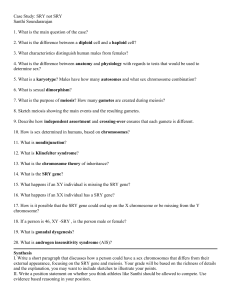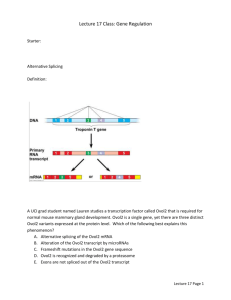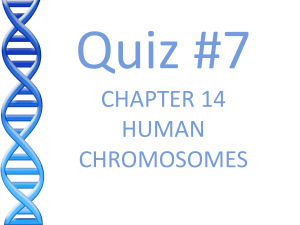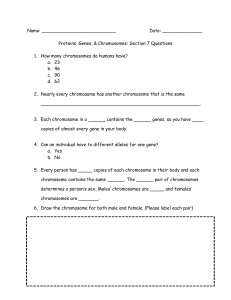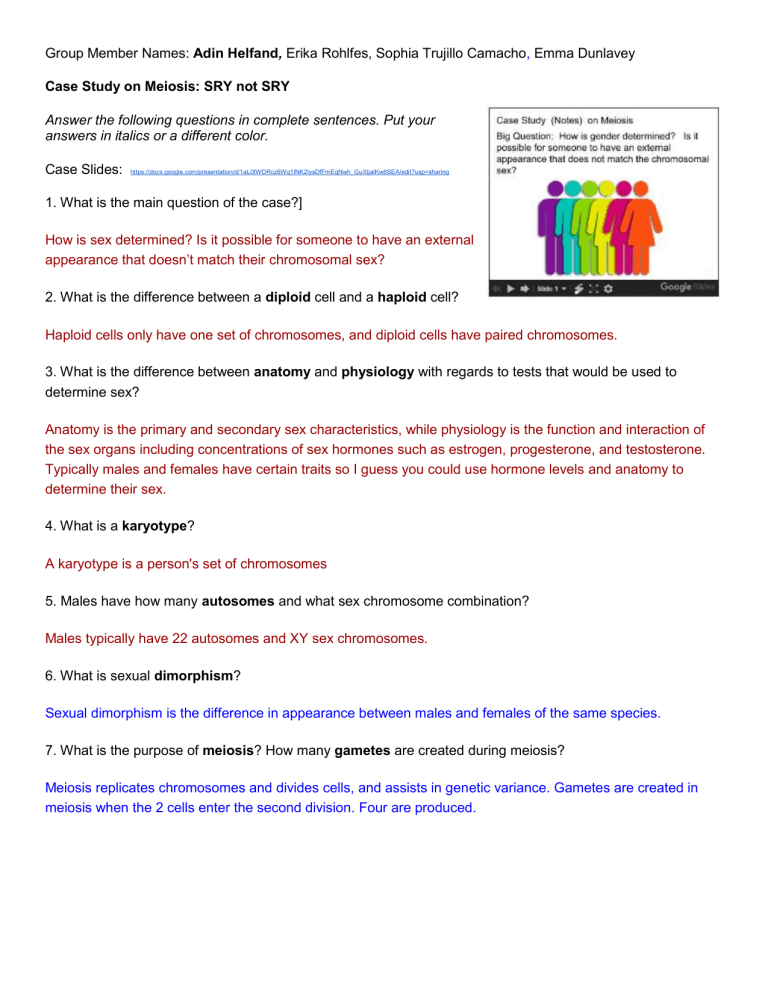
Group Member Names: Adin Helfand, Erika Rohlfes, Sophia Trujillo Camacho, Emma Dunlavey Case Study on Meiosis: SRY not SRY Answer the following questions in complete sentences. Put your answers in italics or a different color. Case Slides: https://docs.google.com/presentation/d/1aL0tWORcz6Wq1lNK2IysDfFmEqNwh_GuXtjalKw8SEA/edit?usp=sharing 1. What is the main question of the case?] How is sex determined? Is it possible for someone to have an external appearance that doesn’t match their chromosomal sex? 2. What is the difference between a diploid cell and a haploid cell? Haploid cells only have one set of chromosomes, and diploid cells have paired chromosomes. 3. What is the difference between anatomy and physiology with regards to tests that would be used to determine sex? Anatomy is the primary and secondary sex characteristics, while physiology is the function and interaction of the sex organs including concentrations of sex hormones such as estrogen, progesterone, and testosterone. Typically males and females have certain traits so I guess you could use hormone levels and anatomy to determine their sex. 4. What is a karyotype? A karyotype is a person's set of chromosomes 5. Males have how many autosomes and what sex chromosome combination? Males typically have 22 autosomes and XY sex chromosomes. 6. What is sexual dimorphism? Sexual dimorphism is the difference in appearance between males and females of the same species. 7. What is the purpose of meiosis? How many gametes are created during meiosis? Meiosis replicates chromosomes and divides cells, and assists in genetic variance. Gametes are created in meiosis when the 2 cells enter the second division. Four are produced. 8. Find a good image of meiosis and paste it here: 9. Describe how independent assortment and crossing-over ensures that each gamete is different. In crossing over, each pair of chromosomes sorts maternal and paternal homologs into the daughter cells independently of the other pairs. The number of combinations possible when the chromosomes assort independently into gametes is doubled. In crossing over, recombinant chromosomes are produced, which combine DNA inherited from each parent. By combining this DNA, chromosomes with new co 10. How is sex determined in humans, based on chromosomes? Sex is determined in humans by a pair of sex chromosomes- one from each parent- that contain genes that determine the sex of the individual. Fathers can either donate an X or a Y chromosome to their child while mothers always contribute an X. Typically, an XY pair signifies that the child is a boy and an XX pair signifies the child is a girl, and both will develop their respective reproductive organs. 11. What is nondisjunction? Nondisjunction occurs during meiosis when chromatids do not separate during the nuclear division process which results in abnormal distribution of chromosomes to daughter cells. 12. What is Klinefelter syndrome? Klinefelter syndrome is when males are born with an extra x chromosome normally caused by nondisjunction. 13. What is the chromosome theory of inheritance? The chromosome theory of inheritance is the theory that identifies chromosomes as the carrier for genetic material and information. 14. What is the SRY gene? The SRY gene stands for the Sex Determining Region of the Y chromosome. It is only after the 7th week of embryonic development that the Y chromosome activates the SRY gene and the gonads develop into testes. Females do not carry the SRY gene and these gonads develop as ovaries. 15. What happens if an XY individual is missing the SRY gene? If an XY individual is missing the SRY gene it means that the individual will be female because the SRY gene develops male characteristics, but their sex organs do not function properly and they are not able to have children. 16. What happens if an XX individual has a SRY gene? When an SRY gene is present, it activates in the 7th week of embryonic development and causes the gonads to mature into male genitalia (testes). XX, SRY individuals will be phenotypically male (can be undermasculine, also produce less androgen than normal males) but genotypically female. 17. How is it possible that the SRY gene could end up on the X chromosome or be missing from the Y chromosome? The presence of the SRY in this circumstance is most commonly caused by the translocation of the SRY gene (loci found on the Y chromosome) onto an X chromosome. Its loci on the Y chromosome is in the pseudoautosomal region, where the short arms of the X and Y chromosome are homologous, enabling the possibility of meiotic recombination. 18. If a person is 46, XY -SRY, is the person male or female? Most people with Swyer syndrome are raised and identify as female. With no SRY gene, the gonads develop as ovaries, the female reproductive organ. And although women with Swyer syndrome are infertile, they may become pregnant and carry to term through egg donation. Depending on the level of gonad development (partial or complete, and/or presence of streak gonads), the individual may appear closer to one gender or the other. This is one of the instances where the decision must defer to that of the person themself. That said, the presence of female genitalia and the functional ability (albeit assisted) to birth a child signifies that the person is female. 19. What is gonadal dysgenesis? Gonadal dysgenesis, or Swyer syndrome, refers to XY females who’ve either lost the SRY gene or it has malfunctioned. 20. What is androgen insensitivity syndrome (AIS)? Androgen insensitivity syndrome refers to the condition of a genetically male person (XY chromosome) who is resistant to male hormones (androgens). This results in the phenotype of a woman but the genotype of a man. Synthesis - Claim, Evidence, Reasoning Consider the following statement: “The Y chromosome is an accurate indicator of a person’s external sex organs.” Do you agree or disagree with this claim? Provide EVIDENCE and REASONING from the case. In most cases, the Y chromosome is an accurate indicator that the person will have male internal sex organs. Present on the Y chromosome is the SRY gene, which signals for the creation of androgens that, in the 7th week of embryonic development, develop the immature gonads into testes- male reproductive organs. That said, there are instances where genetic mutations occur, resulting in phenotypic females with XY chromosomes. This condition is called Swyer Syndrome. In the case of Santhi Soundararajan, a femaleidentifying person with 46 XY SRY- chromosomes, external female genitalia and female reproductive organs are present, though her sex organs are nonfunctional. Therefore, just because someone has a Y chromosome, which typically leads to male external sex organs, there are exceptions caused by genetic mutations.
